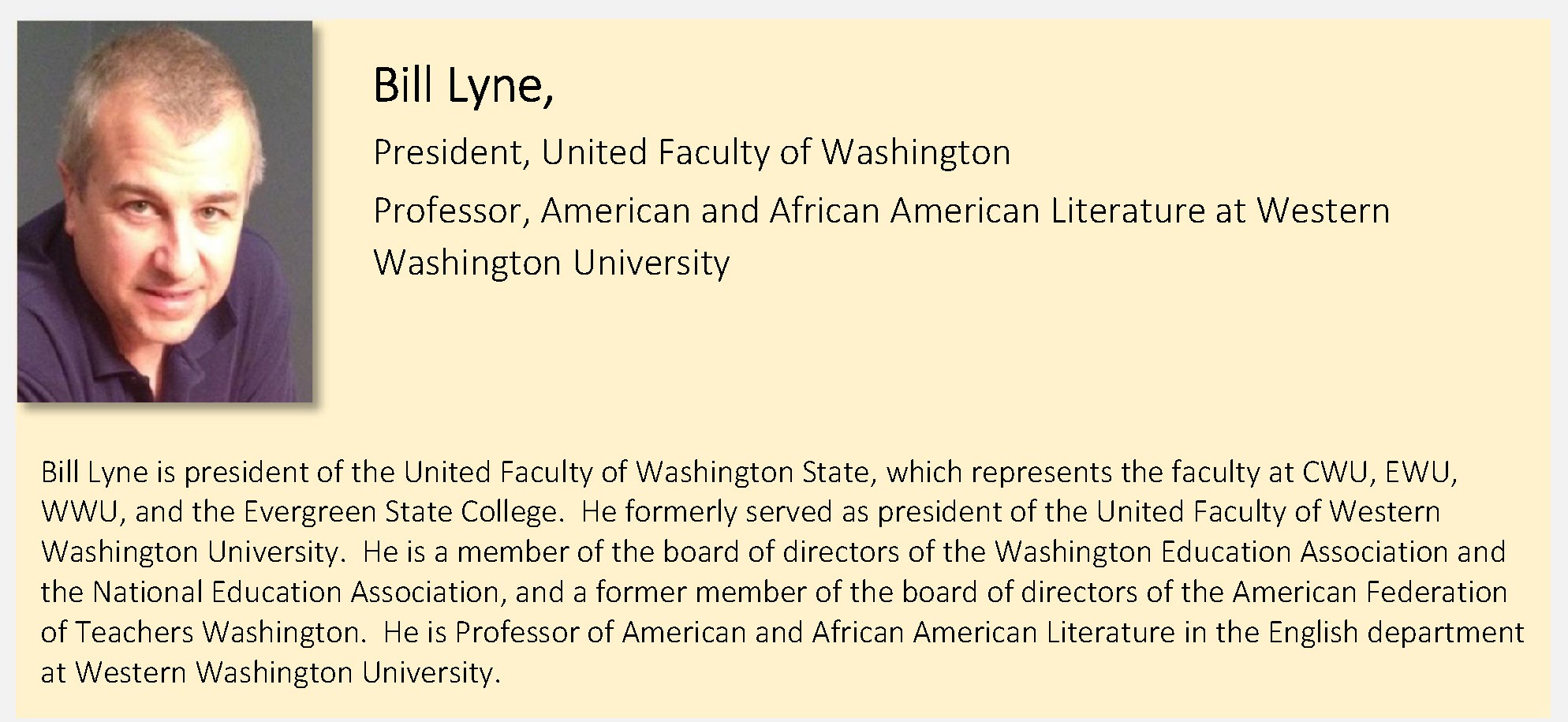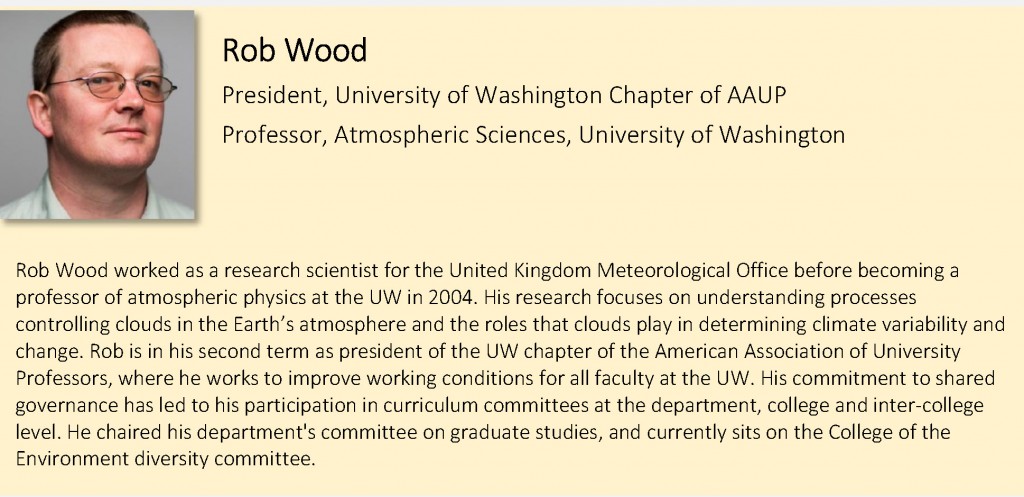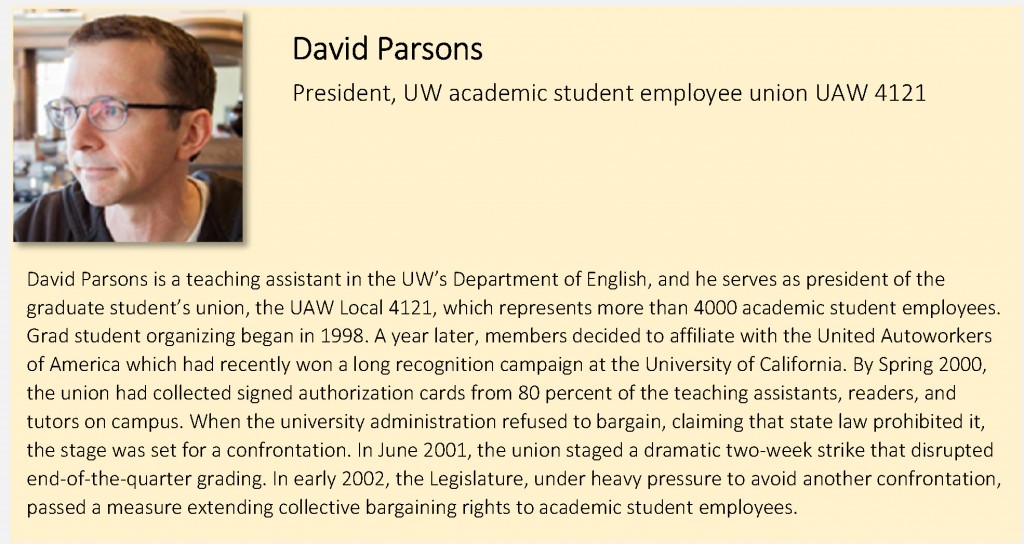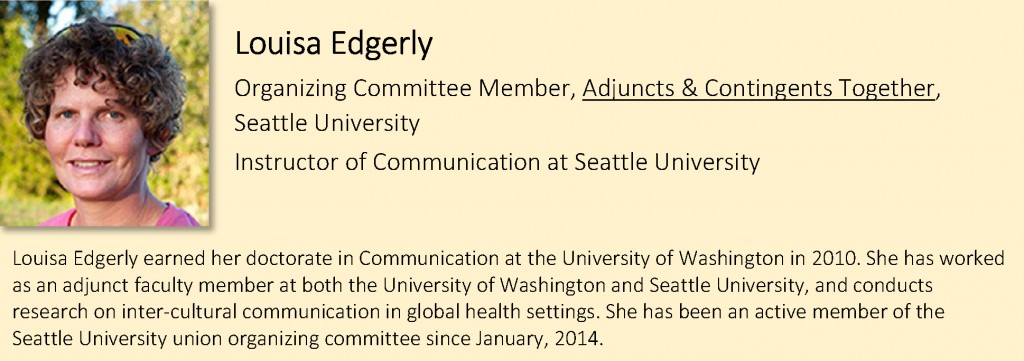The UW’s faculty union is United Faculty of Washington
Link to UW Faculty Forward, the voluntary faculty union at the University of Washington.
White-Collar Unionization Is Good for All Workers
Some have argued that it creates a class divide in labor—they’ve got it backward.
In “The Nation” – https://www.thenation.com/article/white-collar-unionization-is-good-for-everybody/
UW AAUP hosted a team from Rutgers University at our May 9th annual meeting. Guests included David Hughes, AAUP/AFT union president, Karen Stubaus, VP for Academic Affairs and Administration, and Ann Gould, chair of Rutgers’ University Senate. They staged a conversation about how unions, administration and the Senate interact on a large, highly-regarded university campus. Video here.
AAUP expresses dismay about the failure to have an open search for the appointment of a permanent Provost. Statement here: 22 April 2016 memo re provost.
Lilian Taiz, past President of the California Faculty Association (CFA) and professor of history at California State University at Los Angeles, visited the University of Washington April 1, 2016, to host a session on Contract Fights, Budget Battles, and the Future of the University. In case you were unable to attend the event, the session was recorded and can be viewed here.
Guest speakers from the University of Oregon and California State University shared details on how their faculty unions have advanced racial and gender equity at their campuses, 29 Feb 2016 in the Intellectual House. Click here to watch an excellent video of the event!
Gary Rhoades, University of Arizona College of Education, gave talks Feb. 23 and 24 (2016) at UW Seattle and Bothell, “Academic capitalism & collectively re-centering core academic functions & public missions with faculty unions.” His slides: Rhoades UWash22316
UW AAUP endorses House Bill 2546, “Adding a faculty representative to the membership of the Board of Regents at the UW.”
The University of Washington Chapter of the American Association of University Professors supports an amendment to RCW 28B.20.100 to read as follows: “The governance of the University of Washington shall be vested in a board of regents to consist of ten members, one of whom shall be the immediate past chair of the University of Washington faculty senate and one of whom shall be a student. The governor shall select the student member from a list of candidates, of at least three and not more than five, submitted by the governing body of the associated students.((They)) Except for the immediate past chair of the University of Washington faculty senate member, the other members shall be appointed by the governor with the consent of the senate, and, except for the student member, shall hold their offices for a term of six years from the first day of October and until their successors shall be appointed and qualified.” We appreciate the work of Representatives Pollet, Tarleton, Reykdal, Stanford, McBride and Bergquist to introduce the Bill into the 64th Legislature, 2016 Regular Session.
Launching a Faculty Union at the UW: A Conversation with union leaders from other campuses
May 27th 2015, 3-5pm, Intellectual House
On Wednesday May 27th, AAUP’s Annual Meeting focused on launching a faculty union at the University of Washington. Over 100 faculty members attended the event, which took place in the new wǝɫǝbʔaltxʷ – Intellectual House on the Seattle campus. AAUP Chapter secretary Amy Hagopian served as Master of Ceremonies, and introduced six speakers who each summarized their own perspectives on being part of a faculty union and on faculty union organizing efforts.
SPEAKERS [click links to jump to speaker summaries]
- Bill Lyne, President, United Faculty of Washington and Professor, American and African American Literature at Western Washington University
- Louisa Edgerly, Organizing Committee Member, Adjuncts & Contingents Together, Seattle University and Instructor of Communication at Seattle University
- Stuart McLean, Global Studies at University of Minnesota, SEIU Faculty Organizing and Associate Professor, Anthropology at University of Minnesota
- Michael Dreiling, President, United Academics of the University of Oregon (AAUP/AFT) and Associate Professor, Sociology, University of Oregon
- Rob Wood, President, University of Washington Chapter of AAUP and Professor, Atmospheric Sciences, University of Washington
- David Parsons, President, UW academic student employee union UAW 4121
 “Since the four regional universities unionized, higher education as a political issue has risen dramatically in this state. Now, we have the house and the senate fighting over who is going to be perceived as better for higher education. Now, higher education is a voting issue in this state. And if the UW faculty were to unionize, then higher education would be an even more potent voting issue in this state.”
“Since the four regional universities unionized, higher education as a political issue has risen dramatically in this state. Now, we have the house and the senate fighting over who is going to be perceived as better for higher education. Now, higher education is a voting issue in this state. And if the UW faculty were to unionize, then higher education would be an even more potent voting issue in this state.”
Bill Lyne, AAUP Annual Meeting 2015.
Professor Lyne has been involved in academic faculty organizing for two decades and was instrumental in the formation of the United Faculty of Western Washington (UFWW) at Western Washington University after enabling legislation was put in place in 2002. After WWU faculty successfully organized and founded the UFWW in 2006, Lyne served as the first leader of UFWW immediately after serving as chair of the WWU Faculty Senate.
Bill Lyne succinctly summarized the benefits to both faculty and to the university administration of having a faculty union. He contrasted the situation at WWU before and after unionization, explaining how having a collective bargaining unit actually improved shared governance at WWU by allowing the faculty senate to focus on the academic mission rather than pay and working conditions. The two key galvanizing issues at WWU that spurred unionization were pay and workload. Over the three contracts since UFWW formed, faculty have received average salary raises of 30%, bringing WWU faculty within a few percentage points of the median salaries for peer institutions. Faculty workloads have become more manageable, and the further erosion of tenure has been halted. The union and WWU administration do not always see eye to eye, but the relationship has improved immeasurably.
Perhaps above all else, Lyne emphasized the political power that having a faculty union can bring. Lyne now serves as President of the United Faculty of Washington State (UFWS) who are the umbrella organization representing all faculty at Central Washington University, Eastern Washington University, Western Washington University, and The Evergreen State College. As president of UFWS, Lyne is now invited with open arms into the Washington State legislature. The political power that comes from alliance with a powerful union in the state (Washington Education Association, WEA).
Finally, Lyne pointed out that with the additional faculty power associated with collective bargaining comes a bigger responsibility for faculty. It is possible for union efforts to go awry, and it is essential that faculty continually seek ways to ensure representation of the diverse spectrum of faculty and their interests.
Link to court decision on WWU union issues.
Louisa Edgerly gave a brief history of her experiences in being a faculty member involved in the recent unionization campaign at Seattle University (SU), which resulted from the dramatic growth of, and conditions facing, part-time and contingent faculty, who now make up a majority of SU faculty. The administration have been busy with expansion projects (e.g., rejoining Division 1 athletics rather than build office space for faculty) that for the most part have diverged from the university’s key mission, have not served to improve working conditions for faculty and have detracted from improvements in academic quality.
At private universities like SU, tenure and tenure-track faculty are prohibited by law from unionizing, but non-tenure-track (NTT) faculty can do so. SEIU have been helping faculty organize faculty unions for NTT faculty in a number of metropolitan areas around the US (e.g. Washington DC, St. Louis, Boston area). Here in Washington State, faculty at SU, Pacific Lutheran University, Gonzaga and Antioch have worked with SEIU through the Adjuncts and Contingents Together campaign. Edgerly explained how NTT organizing at SU grew from a small effort into a campus-wide campaign. Although prohibited from joining the union, tenure and tenure-track faculty did not oppose the campaign and provided critical support for the campaign and joined in actions on campus.
Edgerly explained that in spring 2014, after a card-signing process, a union election was conducted by the National Labor Relations Board (NLEB), who are the independent body responsible for holding unionization elections in the private sector. Before the votes could be counted, however, the ballots were impounded after the SU administration appealed against the vote on the strange (and perhaps one could argue unchristian) grounds that SU faculty have a religious mission and this should prohibit them from coming together as a union. The SU administration also made the argument that full time NTT faculty at SU are not employees but rather are management. After months of legal hearings and briefs, the NLRB ruled against SU’s claim because the faculty in question did not have specific managerial or religious duties that could prevent them from collective bargaining. SU continue to appeal the ruling and the campaign has heated up in recent months, even culminating in large-scale direct actions on campus and in downtown Seattle. The votes still remain uncounted and SU faculty are eagerly awaiting a final NLRB ruling.
Edgerly pointed out that there are many issues that are shared by both tenured/tenure-track and non-tenure track faculty at SU, including the corporatization of higher education, the lack of meaningful shared governance, and the resulting detrimental impacts on student learning. Having a formalized contract, and allowing all faculty to play a meaningful role, would help to address the isolation that many non-tenure track faculty face. Finally, Edgerly stated that of the unexpected benefits of organizing campaigns has been a transformation of the faculty and campus culture at SU that has resulted in stronger alliances between faculty and the development of closer ties with students.
Stuart McLean focused on his own and other colleagues’ reasons for wanting to create a faculty union at the University of Minnesota. He began by explaining how, throughout his upbringing in the United Kingdom, the idea of free education (including higher education) was a key part of the public mindset, and that most educational faculty in schools and universities are part of a union. Upon coming to the US as a graduate student, McLean was very surprised to find out that most university faculty in the US are not represented by unions, and indeed view the idea of unionizing with skepticism. This stands in direct contrast with the UK, where faculty unions are part and parcel of academic life.
For McLean, the need for faculty union has become increasingly urgent. The erosion of the public higher education system, a system from which McLean personally benefited, is of deep concern. Rising tuition and increasing student debt are making higher education prohibitively expensive for some families. As a result of misguided administrative priorities, politically-motivated public funding cuts, and pressure from corporate sponsors, universities are being pushed toward a narrowly vocational emphasis. This is dangerously disregarding of the basic principles of university education, which aim to expand the minds of students. As a result of the increasing lack of meaningful shared governance, the erosion of tenure, and the bloating of university administrations, McLean found himself wanting to do something to overturn the dangerous direction that public higher education is taking.
McLean also emphasized that the cuts to higher education hurt all faculty and hurt meaningful shared governance, and thinks that forming a union is a way, and perhaps the only way, to push back against the recent shifts in public higher education. Faculty need a voice, not only on campus, but also in state legislatures. McLean pointed out that faculty who have unionized have seen significant improvements in pay and working conditions, but McLean himself is concerned with the bigger goal of ensuring that universities do not simply align themselves to serve narrowly perceived societal needs, but remain active agents of change. He attacked the frequently encountered notion that unions are outdated entities belonging to a “bygone moment” in labor relations, whereas in his view, a union in the early 21st century, like a university in the early 21st century, can be whatever we are prepared to make it.
Faculty at the University of Minnesota (UMN) had run a unionization campaign in the late 1990s after the UMN Board of Regents threatened to remove tenure from faculty. That campaign was very close to being a success but the Board of Regents reversed their decision shortly before the unionization vote, which took the wind from the campaign sails. However, in the last few years a new organizing campaign has begun (Academics United, supported by SEIU). Threats by state governments to abolish tenure are becoming very real (e.g., the recent activities by the Wisconsin governor and legislature), and while there has yet to be a repeat of the 1990 attempt in Minnesota, there are major concerns that such attempts may be around the corner.

“We have these conflict resolution strategies…..in order to build that framework of shared governance and renew it and transform it through the union.”
Michael Dreiling, AAUP Annual Meeting 2015.
Michael Dreiling began with a 1938 quote from Albert Einstein: “I consider it important, indeed urgently necessary, for intellectual workers to get together, both to protect their own economic status and also, generally speaking, to secure their influence in the political field”. Dreiling then asked what Einstein’s quotation really means and how its goal may be fulfilled in practice. Dreiling explained how for many years, the faculty at the University of Oregon struggled to have a collective voice through the faculty senate. In the early 2000s, faculty had drafted a white paper laying out a new faculty salary policy, which was all but ignored by the administration, leaving U of O faculty lagging behind peer institutions. But once the U of O faculty organized, the faculty salary policy became a legally-binding component of the contract between the union and the administration. Within a few years following the signing of their first contract, faculty salaries had increased on average by 11%.
Another major problem that matters to faculty at the U of O and matters greatly at the University of Washington is also being solved via collective bargaining. By changing the incentive structures that originally drove the rise of contingent faculty, the U of O are beginning to reverse the economic and job security disparities that have grown between tenured/tenure-track and NTT faculty over the last 10-15 years. Interestingly, Dreiling makes a compelling argument for why a single “wall to wall” faculty union, with a single collective bargaining unit (comprising practically all faculty) can work extremely well. The union enabled the reclassification of three quarters of their long-serving NTT instructional faculty with short term contracts to promotable positions with annual reviews, sabbatical opportunities, and other benefits. This reclassification changed the logic by which a university makes hiring decisions.
Dreiling finished with the political field part of Einstein’s quote, emphasizing how the union enabled a much increased voice in the state capitol. Even as the faculty were building the union, they found that they were able to exert more leverage at the state capitol. After forming the union, Dreiling recounted how state legislators in Salem would comment on how refreshing it is to hear a real faculty member’s voice rather than that of an administrator. Not having a strong faculty voice in the state legislature is a critical void that needs to be filled.
With the union at the U of O, collectively the union and administration are able to work on longstanding problem areas that had previously been stuffed under the rug. There is now thoughtful, meaningful debate among faculty to solve specific problems that previously were ignored.

Rob Wood laid out a case for forming a faculty union at the University of Washington. Wood grew up with the fundamental belief that public education, including higher education, is a public good that serves to provide knowledge and education to citizens. In the United States, and particularly acutely in Washington State, this entire system is under threat. The UW needs leadership who will prioritize instruction, innovation, and full funding for the university’s mission of discovery and education – and we need a greater faculty voice to uphold this mission.
As AAUP’s founder the philosopher John Dewey once wrote, “We do not learn from experience… we learn from reflecting on experience.” Faculty are experiencing an upheaval in higher education, and particularly in public higher education. Across the United States, legislators and governors are in the process of systematically dismantling what have been some of the most powerful engines of innovation, education and wealth creation that this country has ever seen. US universities have been the envy of the world for over a half century. Even today, almost half of the top 100 universities in the world (The Times World University Rankings) are in the US, and a quarter of them are public universities.
But the very concept of a state public university – a system that brings affordable higher education to its citizens – the very system that allows our state’s citizens to participate fully in society, is failing our citizens. In Washington State, only one in four public school graduates is expected to finish college within six years. State spending on higher education has fallen precipitously, by 45% since 2008. And even before the Great Recession, funding for Washington State’s colleges and universities was far from sufficient. Since 1990, the tuition burden on student families at UW has increased by a factor of four in real terms and the state’s contribution to the total cost of educating students has fallen to less than a quarter.
But we do not learn from experience – it is only our reflection on this experience that can lead us to declare that enough is enough and see the writing on the wall. Academic freedom is under great threat by the loss of faculty job security across the university and the rise in contingent academic labor. Seventy percent of UW faculty are now in contingent positions of one sort or another. Contingency in our profession is in danger of undermining our social contract with the public as educators and researchers. It is difficult to innovate and deliver first class education when instructors are working hand to mouth, sometimes without even the “luxury” of reasonable office space. Salaries and working conditions for lecturers are woefully inadequate. And because almost 60% of lecturers at UW are women, the implications for gender inequity are clear.
Faculty are not in control at UW. Academic freedom means nothing if the faculty are not given the resources and power to take innovative leaps in research and teaching that they are supposedly free to do. For example, the lack of adequate and affordable childcare provision for UW faculty is hurting the ability of the next generation of faculty to perform their work. More than one third of faculty respondents to this year’s annual AAUP faculty survey indicated that an inability to obtain or pay for childcare has undermined their ability to perform their jobs, and 60% of faculty respondents are dissatisfied with the availability of childcare.
A smaller and smaller fraction of the UW’s core budget is being spent on its two key missions of discovery and education. Instruction and research compensation now accounts for less than half (49.6%) of the total employee compensation, down from 53% only five years ago.
Where is this all heading and what can we do about it? Washington State citizens have proven themselves innovative in seeking and finding progressive solutions to complex problems. We were the first city in the US to pass $15 now and the first state in the nation to legalize gay marriage by popular vote. Our engines of innovation touch every corner of the globe. We want our university to grow and become a truly world-class institution. To do this, we need a major investment in the faculty. We need an investment in salaries and job security and we need to end the woefully low salaries for lecturers at UW. But at the same time, we need to be innovative in allowing faculty, not just UW lobbyists, to interact with legislators and improve our political standing in Olympia and advocate for creative solutions. A unionized faculty can facilitate this.
Finally, it is worth thinking outside the box. How much would it cost to provide free undergraduate education to Washington State residents? Empowered faculty can help to push new innovations such as this. What about a public endowment for the UW? With the collective strengths of the faculty working together, novel ideas in higher education financing can become a possibility.
What will become of innovation if the UW claims the intellectual property of its faculty? We need a union to become a meaningful player in deciding the future direction of the university. From Capital projects to online education, to improving our grievance system, to giving teeth to the faculty senate and a new faculty salary policy that values loyalty from all faculty, and provides opportunities for innovative education and research.
This is why the UW AAUP chapter is supporting the creation of a faculty union at the UW. We are calling the campaign Faculty Forward for obvious reasons. Creating a union will be challenging, but look forward 10, 15, 20 years, and consider what may become of UW without collective faculty power to steer the direction of the university. We may be about to experience the destruction of our profession. At that time, it will be too late to reflect on such experience.

David Parsons began by thanking the AAUP-UW chapter for their support over the years, and recounted his enthusiasm at hearing that the UW faculty are starting an organization campaign. David discussed the process by which the academic student employees (ASEs) at the UW organized (in 2004) and provided some details on their contracts and what they had achieved for student workers at UW.
Parsons gave an excellent example of how the administration can sometimes be an excellent organizer tool. Prior to forming the union, the UW argued that the graduate students and student employees were not employees at all because they did not provide a service to the university. Of course, any of us who are working with graduate students know how important their contributions are to both instruction and research at the UW. The students were able to make the case that they indeed provide a critical service to the UW. In 2002 students helped pass enabling legislation in the state that would allow them to collectively bargain. The UW challenged this, which eventually led to the longest PERC hearing in state history. Eventually the UW gave up their appeal, and the ASEs unionized. Remarkably, their first contract was bargained in just six weeks.
A total of six contracts have been bargained to date. Parsons demonstrated how some of the early arguments made by the administration about how an ASE union would corrupt higher education, strain relationships between mentors and mentees, jeopardize academic quality, promote mediocrity etc., have not panned out at all. Indeed, ASE salaries are now far more competitive than they were, which improves recruitment of high quality students. Parsons also discussed how, despite the advent of fee-based programs at UW (many of which have emerged to replace tuition-based programs), ASEs were able to maintain parity in salaries and working conditions. ASEs continue to be key supporters of the teaching and research missions at UW and have found ways to turn this support into action through collective bargaining.


